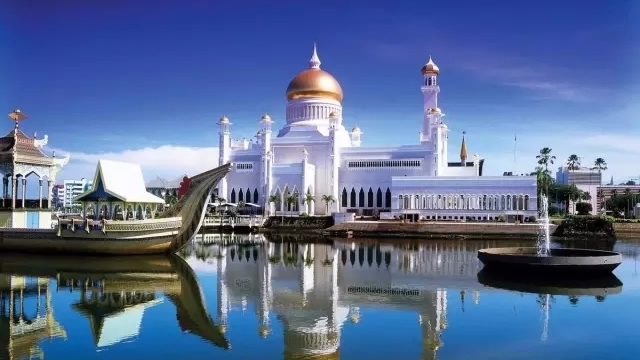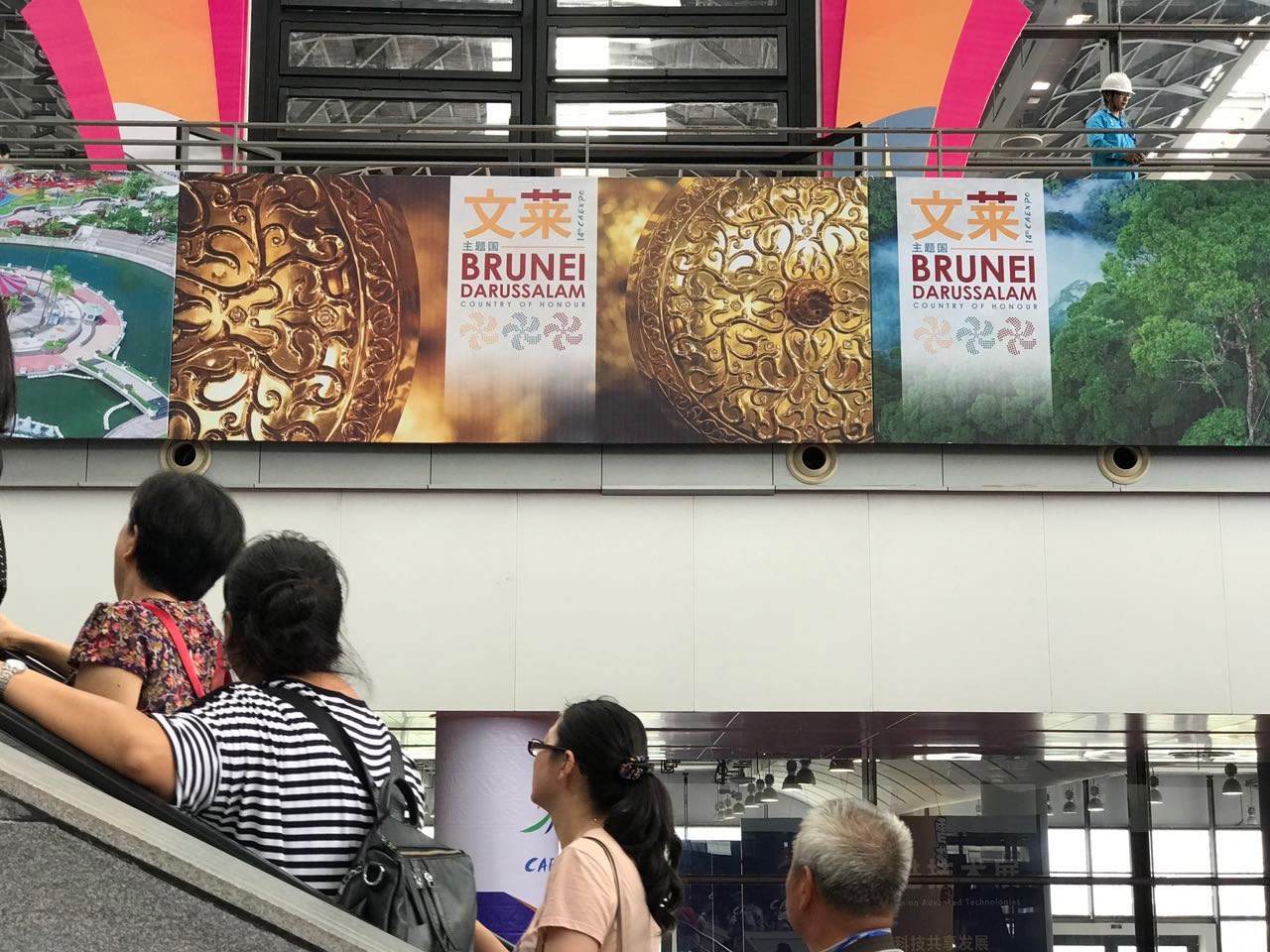
China
23:18, 12-Sep-2017
CAEXPO encounters: Brunei now on Chinese tourists’ radar
Nadim Diab

Guarding Brunei’s booth at the China-ASEAN Expo (CAEXPO) in the southern Chinese city of Nanning are four representatives of the country’s major travel agencies. While loud music blasts from the stalls of other participating nations attracting a curious crowd, the small sultanate’s spot is an oasis of calm. The delegates greet passersby with an inviting look and a big smile, and when a visitor approaches for a question or a closer examination of the piles of pamphlets, the conversation automatically kicks off in Mandarin.
It’s hardly a shocker that Bruneian tourist guides master the language that most struggle with. For them, it’s a business necessity as the country deals with an increasingly steady stream of travelers from the world’s largest exporter of tourists.
"Ninety-five percent of our market is from China," Peter H.J. Chieng, managing director of Majestic Tours told CGTN. "The Chinese tourism market for Brunei is one of our priority markets. It is the only market we have identified that provides mass tourism."

Peter Chieng, managing director of Majestic Tours. /CGTN Photo
Peter Chieng, managing director of Majestic Tours. /CGTN Photo
As far back as 2007, the travel agency realized the potential of the Chinese market, and focused on pulling travelers from the Middle Kingdom to the southeastern sultanate.
"We identified that China is going to be one of the main movers in terms of outbound tourism to other countries and the rest of the world. With such a high rate of growth every year and being of such a volume, even a small percentage would be good for us."
Outbound tourism: a Chinese export
China is now the world’s number one in the size of outbound tourists. According to the United Nation World Tourism Organization (UNWTO), 135 million Chinese traveled abroad in 2016 – a six percent increase year on year. Among them, a little over 40,000 made their way to Brunei, up 10.7 percent on annual basis.
In Chinese standards, the figure might be paltry, but for Brunei, which recorded 219,000 international arrivals through its airport in the same year, it is big business.
China is the second largest source of tourists to the tiny country after Malaysia, and the main contributor for its leisure and holiday market, accounting for 39 percent of the total.
"Chinese tourists help the economy of Brunei," noted Venie Ho, tour supervisor at Wing On Travel. Last year, revenue from Chinese holidaymakers reached 4.8 million US dollars, according to data by the Tourism Development Department.

Venie Ho, tour supervisor at Wing On Travel. /CGTN Photo
Venie Ho, tour supervisor at Wing On Travel. /CGTN Photo
Inevitable tourist magnet
Tourism promotion gained traction in the oil-rich country when the black gold began losing its sheen in 2015 as a global glut sent prices on a free fall. Brunei’s decision to diversify its economic drivers was translated in the elevation of the tourism sector to a ministerial status in the same year.
But competition for travelers with an appetite for exotic getaways is cutthroat among ASEAN countries whose tropical paradises, lush laurels and majestic scenery have made their way to the top of bucket-list destinations.
Brunei had its own ammunition in the battle for Chinese globetrotters’ attention. And the secret lies in how the country is being marketed.

Brunei is the Country of Honor at this year's CAEXPO. /CGTN Photo
Brunei is the Country of Honor at this year's CAEXPO. /CGTN Photo
Security is key, said Chieng.
Brunei is "a very safe country. People who have gone there have no worries about walking on the street or having a bag over their shoulders" without being dragged away like in other countries, he noted.
"People in Brunei are very friendly. They are very happy to see foreigners coming in. They don’t have the intention to hurt anybody," Ho said, joking that she reminds Chinese tourists who join her tours that they should not worry about crossing the street.
"This is Brunei, you don’t stop for cars. Cars stop for you."
Fauna, flora and faith
But it’s not only the nature of the people that is a major tourist draw for Chinese. It’s nature itself. Brunei is one big botanical garden and its rich fauna and flora have been the answer for city dwellers escaping hectic schedules, busy streets and polluted air.
"The (Ulu Temburong) National Park is the most pristine forest you can actually see in Southeast Asia. We take (Chinese tourists) to stay overnight there. Early in the morning, they get a glimpse of the sunrise. Later, they see birds going after insects. It’s a wonderful sight. It’s pretty amazing for city folks," Chieng noted.
"Brunei is a very good place to relax, to release some stress," Ho remarked.
Both travel agents stressed that the country offers an alternative traveling experience for Chinese holidaymakers. Alcohol and cigarettes are off the menu in Brunei, but that does not stop the Muslim country from serving up a different kind of entertainment – one that is educational, based on Malay culture and royal heritage.

Sampling local food from Brunei. /CGTN Photo
Sampling local food from Brunei. /CGTN Photo
"A lot of Chinese tourists are curious about the royal family. One of Brunei’s most selling points is religion. (The capital) has beautiful mosques, one is the Jame’Asr Mosque and the other is Omar Ali Saifuddin. We bring them in to see the praying halls. They learn a lot about the Islamic religion and it’s quite eye opening for them," Chieng said.
Cashing in on middle-class
China’s growing middle-class has also been a boon for businesses in Brunei. Traveling to the country does not come at a cheap price tag. A night’s stay at the national park could set a traveler back around 1,500 yuan (230 US dollars). Meanwhile, tours range between 3,000 and 4,000 yuan (450-600 US dollars) for three to four days, but could climb to 9,000 yuan (1,300 US dollars) for six days.
Relaxed visa policies and increased air connectivity, including two newly opened routes from Kunming in southwest China’s Yunnan Province and Nanning in Guangxi Zhuang Autonomous Region to Bandar Seri Begawan in July, have helped attract more Chinese tourists to Brunei. Yet their visits are usually part of a two-country itinerary where Brunei is a stop along the route.

Getting creative with calligraphy at Brunei's CAEXPO booth. /CGTN Photo
Getting creative with calligraphy at Brunei's CAEXPO booth. /CGTN Photo
Will Brunei ever be the final destination?
"To be frank, it will be hard. Brunei is a very small country and tourism is at its very beginnings," Ho said, noting that the government is doing its best in marketing the country’s highlights.
Brunei is the Country of Honor at this year’s CAEXPO, and travel agents are hoping that their country taking center stage at one of the biggest collaborative regional events in Southeast Asia will help put the spotlight on the country’s burgeoning tourism sector.

SITEMAP
Copyright © 2018 CGTN. Beijing ICP prepared NO.16065310-3
Copyright © 2018 CGTN. Beijing ICP prepared NO.16065310-3